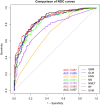Predictive model of acute kidney injury in critically ill patients with acute pancreatitis: a machine learning approach using the MIMIC-IV database
- PMID: 38264967
- PMCID: PMC10810629
- DOI: 10.1080/0886022X.2024.2303395
Predictive model of acute kidney injury in critically ill patients with acute pancreatitis: a machine learning approach using the MIMIC-IV database
Abstract
Background: Acute kidney injury (AKI) is a common and serious complication in severe acute pancreatitis (AP), associated with high mortality rate. Early detection of AKI is crucial for prompt intervention and better outcomes. This study aims to develop and validate predictive models using machine learning (ML) to identify the onset of AKI in patients with AP.
Methods: Patients with AP were extracted from the MIMIC-IV database. We performed feature selection using the random forest method. Model construction involved an ensemble of ML, including random forest (RF), support vector machine (SVM), k-nearest neighbors (KNN), naive Bayes (NB), neural network (NNET), generalized linear model (GLM), and gradient boosting machine (GBM). The best-performing model was fine-tuned and evaluated through split-set validation.
Results: We analyzed 1,235 critically ill patients with AP, of which 667 cases (54%) experienced AKI during hospitalization. We used 49 variables to construct models, including GBM, GLM, KNN, NB, NNET, RF, and SVM. The AUC for these models was 0.814 (95% CI, 0.763 to 0.865), 0.812 (95% CI, 0.769 to 0.854), 0.671 (95% CI, 0.622 to 0.719), 0.812 (95% CI, 0.780 to 0.864), 0.688 (95% CI, 0.624 to 0.752), 0.809 (95% CI, 0.766 to 0.851), and 0.810 (95% CI, 0.763 to 0.856) respectively. In the test set, the GBM's performance was consistent, with an area of 0.867 (95% CI, 0.831 to 0.903).
Conclusions: The GBM model's precision is crucial, aiding clinicians in identifying high-risk patients and enabling timely interventions to reduce mortality rates in critical care.
Keywords: Acute kidney injury; MIMIC- IV database; acute pancreatitis; machine learning; prediction model.
Conflict of interest statement
No potential conflict of interest was reported by the author(s).
Figures




Similar articles
-
Machine Learning for the Prediction of Acute Kidney Injury in Critically Ill Patients With Coronary Heart Disease: Algorithm Development and Validation.JMIR Med Inform. 2025 May 28;13:e72349. doi: 10.2196/72349. JMIR Med Inform. 2025. PMID: 40383933 Free PMC article.
-
Machine learning for the prediction of acute kidney injury in patients with sepsis.J Transl Med. 2022 May 13;20(1):215. doi: 10.1186/s12967-022-03364-0. J Transl Med. 2022. PMID: 35562803 Free PMC article.
-
Machine learning models for mortality prediction in critically ill patients with acute pancreatitis-associated acute kidney injury.Clin Kidney J. 2024 Sep 11;17(10):sfae284. doi: 10.1093/ckj/sfae284. eCollection 2024 Oct. Clin Kidney J. 2024. PMID: 39385947 Free PMC article.
-
Predicting renal function recovery and short-term reversibility among acute kidney injury patients in the ICU: comparison of machine learning methods and conventional regression.Ren Fail. 2022 Dec;44(1):1326-1337. doi: 10.1080/0886022X.2022.2107542. Ren Fail. 2022. PMID: 35930309 Free PMC article. Review.
-
Machine learning in predicting cardiac surgery-associated acute kidney injury: A systemic review and meta-analysis.Front Cardiovasc Med. 2022 Sep 15;9:951881. doi: 10.3389/fcvm.2022.951881. eCollection 2022. Front Cardiovasc Med. 2022. PMID: 36186995 Free PMC article.
Cited by
-
Construction and validation of risk prediction models for renal replacement therapy in patients with acute pancreatitis.Eur J Med Res. 2025 Feb 4;30(1):70. doi: 10.1186/s40001-025-02345-5. Eur J Med Res. 2025. PMID: 39905525 Free PMC article.
-
AI and Machine Learning for Precision Medicine in Acute Pancreatitis: A Narrative Review.Medicina (Kaunas). 2025 Mar 29;61(4):629. doi: 10.3390/medicina61040629. Medicina (Kaunas). 2025. PMID: 40282920 Free PMC article. Review.
-
Advances in the clinical application of machine learning in acute pancreatitis: a review.Front Med (Lausanne). 2025 Jan 7;11:1487271. doi: 10.3389/fmed.2024.1487271. eCollection 2024. Front Med (Lausanne). 2025. PMID: 39839637 Free PMC article. Review.
-
AI's pivotal impact on redefining stakeholder roles and their interactions in medical education and health care.Front Digit Health. 2024 Nov 5;6:1458811. doi: 10.3389/fdgth.2024.1458811. eCollection 2024. Front Digit Health. 2024. PMID: 39564581 Free PMC article.
-
Artificial intelligence models for predicting acute kidney injury in the intensive care unit: a systematic review of modeling methods, data utilization, and clinical applicability.JAMIA Open. 2025 Jul 3;8(4):ooaf065. doi: 10.1093/jamiaopen/ooaf065. eCollection 2025 Aug. JAMIA Open. 2025. PMID: 40620479 Free PMC article. Review.
References
-
- Acute Pancreatitis: Diagnosis and Treatment - PubMed . https://pubmed.ncbi.nlm.nih.gov/36074322/. (accessed May 11, 2023).
MeSH terms
LinkOut - more resources
Full Text Sources
Medical
